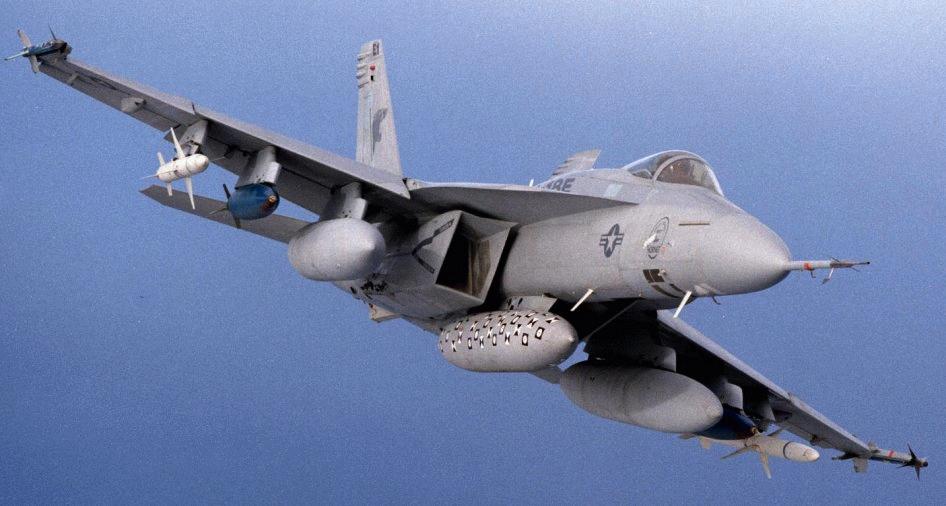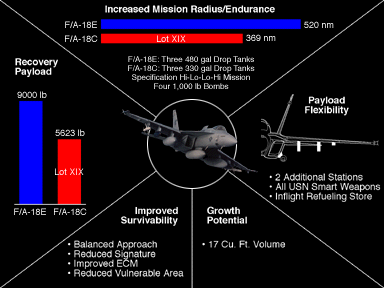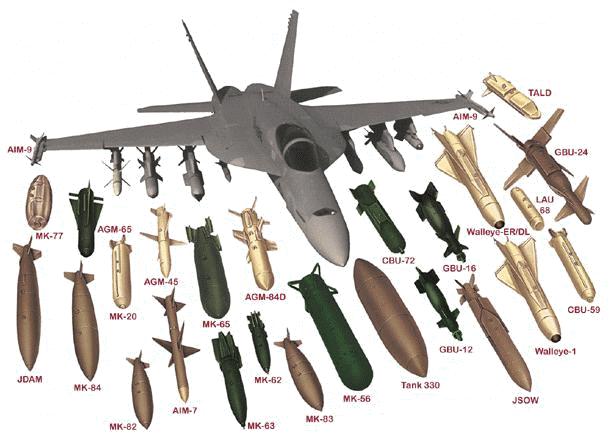

| Aircraft | F/A-18C/D"Hornet" (McDonnell Douglas; Major Subcontractor: Northrop ) | |
| Type | Multi-role attack and fighter aircraft | |
| Year | September 1987 (C/D models) | |
| Engine | Two F404-GE-402 enhanced performance turbofan engines :17,700 pounds (8,027 kg) static thrust per engine | |
| Wingspan | 40 feet 5 inches (13.5 meters) | |
| Length | 56 feet (16.8 meters) | |
| Height | 15 feet 4 inches (4.6 meters) | |
| Weight | 51,900 pounds (23,537 kg) | |
| Max. speed | Mach 1.7+ | |
| Ceiling | 50,000+ feet | |
| Crew | 1:A,C and E models | 2:B,D and F models |
| Armament | One M61A1/A2 Vulcan 20mm
cannon:
AIM 9 Sidewinder AIM 7 Sparrow AIM-120 AMRAAM Harpoon; Harm (High Anti-Radiation Missile) Shrike; SLAM SLAM-ER; Walleye Maverick missiles; Joint Stand-Off Weapon (JSOW) Joint Direct Attack Munition (JDAM); gravity bombs rockets; |

| Aircraft | F/A-18E/F"Super Hornet" (McDonnell Douglas) | |
| Type | Multi-role attack and fighter aircraft | |
| Year | December 1995 (E/F models) | |
| Engine | Two F414-GE-400 turbofan engines :22,000 pounds (9,977 kg) static thrust per engine | |
| Wingspan | 44.9 feet (13.68 meters) | |
| Length | 60.3 feet (18.5 meters) | |
| Height | 16 feet (4.87 meters) | |
| Weight | 66,000 pounds (29,932 kg) | |
| Max. speed | Mach 1.8+ | |
| Ceiling | 50,000+ feet | |
| Crew | 1:A,C and E models 2:B,D and F models | |
| Armament | One M61A1/A2 Vulcan 20mm
cannon:
AIM 9 Sidewinder AIM 7 Sparrow AIM-120 AMRAAM Harpoon Harm (High Anti-Radiation Missile) Shrike SLAM SLAM-ER Walleye Maverick missiles Joint Stand-Off Weapon (JSOW) Joint Direct Attack Munition (JDAM) gravity bombs rockets |
The aircraft's survivability was proven by Hornets taking direct hits from surface-to-air missiles, recovering successfully, being repaired quickly, and flying again the next day. The F/A-18 is a twin engine, mid-wing, multi-mission tactical aircraft. The F/A-18A and C are single seat aircraft. The F/A-18B and D are dual-seaters. The B model is used primarily for training, while the D model is the current Navy aircraft for attack, tactical air control, forward air control and reconnaissance squadrons. The newest models, the E and F were rolled out at McDonnell Douglas on Sept. 17, 1995, and are currently undergoing further testing at the Patuxent Naval Air Station in Maryland. The E is a single seat while the F is a two-seater.
All F/A-18s can be configured quickly to perform either fighter or attack roles or both, through selected use of external equipment to accomplish specific missions. This "force multiplier" capability gives the operational commander more flexibility in employing tactical aircraft in a rapidly changing battle scenario. The fighter missions are primarily fighter escort and fleet air defense; while the attack missions are force projection, interdiction, and close and deep air support.
The F/A-18C and D models are the result of a block upgrade in 1987 incorporating provisions for employing updated missiles and jamming devices against enemy ordnance. C and D models delivered since 1989 also include an improved night attack capability.
Source-United States Navy

